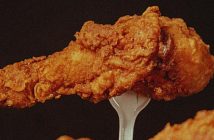
Congee, the ultimate comfort food
Rice provides more than one-fifth of the calories consumed by human beings across the globe, and China is one of the world’s largest producers. Small wonder, then, that the Chinese phrase chi fan (吃饭), which literally means “eating rice,”used to mean eating in general.
Common white rice is preferred by many people and is actually produced by polishing the grains. The seeds of the rice plant are milled using a rice huller to remove the outer husks of the grain. This allows each grain to keep fresh longer and to retain a soft texture, making it easier to digest.
Though white rice lacks certain essential nutrients (a diet that consists of little more than white rice would lead to beriberi, a thiamine deficiency disease) all rice – no matter its color – is a rich source of protein and essential amino acids when combined with beans, nuts and seeds.
Rice cooked with an excess of water makes congee (or zhou (粥) in Putonghua) and allows limited quantities of grains to stretch to feed additional mouths. This “poor man’s feast” also happens to be one of the most loved Chinese comfort foods.
Doting moms dole out congee to kids at the first sign of illness. A good pot of congee requires incredible patience and experience to make, as it demands constant attention to prevent burning and to achieve precisely the right consistency.
Different regions of China make different styles of congee, each varying widely in thickness and in condiments utilized. A good bowl of congee in Chaozhou, for instance, is thin and lumpy with grains of rice. It is usually cooked in a clay pot until the rice just begins to lose shape in the clear liquid broth. There are about 100 kinds of condiments, including pickles, bean curd, salted fish and salted eggs. Eating Chaozhou congee is like slurping down a hearty bowl soup filled with of different flavors.
At the other end of the spectrum, Fujian-style congee contains relatively little water and can be eaten with chopsticks. It is more like a bowl of wet rice, and the presence of individual, intact grains of rice is the mark of a good congee cook. Fujian folks like to add a little more water than is typical to cook rice, and they avoid stirring too often to prevent the rice granules from breaking up. They tend to flavor the zhou with pickles, peanuts, pork floss, or even a baby oyster omelette. Then there’s Cantonese-style congee. Here, kitchen experts cook the rice until it breaks up and mixes with the water to form a viscous liquid. At its best, Cantonese-style congee is light, fluffy and incredibly satisfying – the thick white porridge is likened to cotton or clouds. It’s often served to people who are not feeling well, sometimes even without salt.
When eaten at breakfast, a variety of ingredients – shredded beef, lean pork, sliced fish and eel, crabmeat, salty duck eggs and blood pudding – are added to the thick soupy base to make a full meal.
A good bowl of homemade congee proves that sometimes the simplest foods are the best. To prepare your own, simply toss a handful of rice in a pot and fill it with water. From there it’s a matter of turning up the heat, continually stirring and hoping for the best.
To impress congee connoisseurs, you can even add delicacies such as dried oysters, dried scallops or abalone. But no matter how you make it, this quintessential comfort food is as gentle and delicate to the taste as it is warming to the stomach and spirit.
 Recipe
Recipe
Cantonese-style Congee
(serves 4)
Ingredients:
500g lean pork
2 pidan (皮蛋, thousand-year-old eggs)
1 cup white rice
5 cups water
2 tbsp oil
Salt to taste
Select short-grain rice with a round shape. Prior to cooking, soak the rice in oil, salt and about 2 tablespoons of water for 30 minutes to an hour.
In a large pot, combine the rest of the water with the rice and its soaking water. Bring to a boil on high heat. Allow the rice to boil for 15-20 minutes, then turn the heat to low. Simmer for about an hour, stirring often to prevent sticking. If the rice starts to stick and burn, do not scrape it off the bottom, as the burned rice will mix  into the congee and ruin it. Observe closely to see if more water is needed, and only add boiling water. When finished, the rice should have completely disintegrated into the water; the resulting congee should be quite thick.
into the congee and ruin it. Observe closely to see if more water is needed, and only add boiling water. When finished, the rice should have completely disintegrated into the water; the resulting congee should be quite thick.
Meanwhile, slice the pork into bite-sized pieces and roughly dice up the pidan, or thousand-year-old egg. When the congee is at the desired consistency, add the pork and stir. When the pot starts to simmer again, add the pidan and stir until heated thoroughly.
Garnish with chopped spring onions and sesame or refried crullers. Serve piping hot. Makes four servings.



